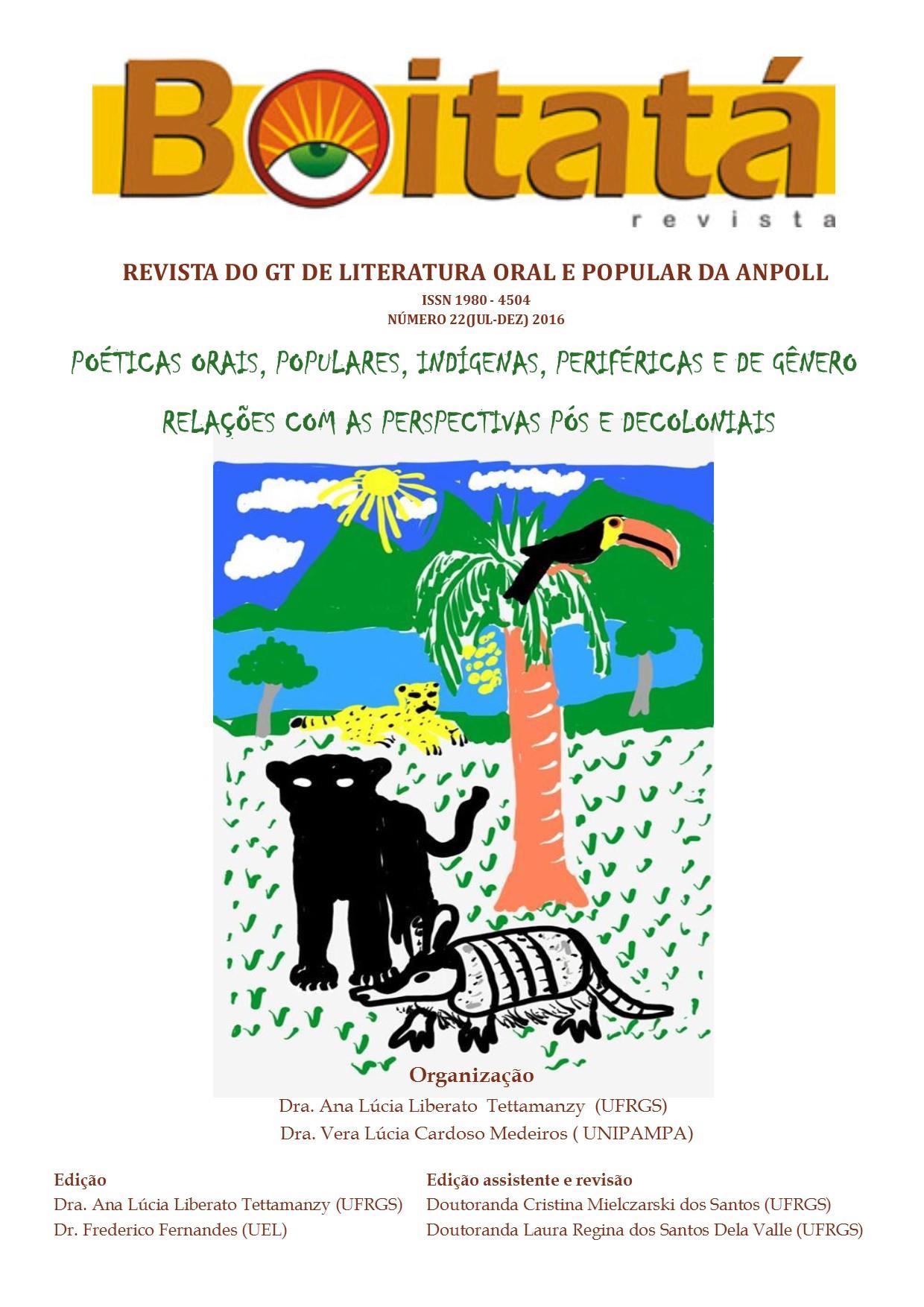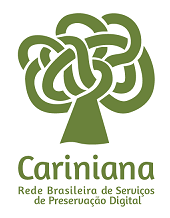The Xokleng myth and the imaginary of fear as memory and language of descent of colonizers from the high Valley of Itajaí - SC
DOI:
https://doi.org/10.5433/boitata.2016v11.e31281Keywords:
Memory, Language, Imaginary of Fear, Xokleng Myth, Alto Vale do Itajaí.Abstract
The myth, to establish itself as such, constitutes arrays-archetypical elements that are narrated and tissues for a given group at a given time and space. Similarly, the strengthening of the myth is through the use of repeated memory exercises and language in the quest to keep alive and updated their perception about a particular event, person, culture, etc. The wires that make up the fabric of these mythical narratives are dyed by socio-historical-cultural context of social actors, so their feelings, experiences and predilections bolster the construction of narratives. This curtails social path and entangles the components of this semantic basin formed in essence by symbolic images constellations, which are now recognized and disseminated even generations. In the case of the narratives of the descendants of settlers of Alto Vale do Itajaí - SC, about Xokleng, elemental traits present an Imaginary of the fear resulting of relationships established by indigenous groups and the first settlers of the region. Finding that evidenced in oral narratives collected in the same place. Understand the strength of this imaginary rescued by memory and reaffirmed by the language is the purpose it is intended that work.Metrics
Metrics Loading ...
References
DURAND, Gilbert. Sobre a exploração do imaginário, seu vocabulário, métodos e aplicações transdiciplinares: mito, mitanálise e mitocrítica. Revista da Faculdade de Educação, v.11, n. 1-2, p. 243-273, 1985.
DURAND, Gilbert. As estruturas antropológicas do imaginário: introdução à arquetipologia geral. Tradução de Helder Godinho. São Paulo: Martins Fontes, 2002.
FERREIRA-SANTOS, Marcos; ALMEIDA, Rogério de. Aproximações ao imaginário: bússolas de investigação poética. São Paulo: Képos, 2012.
MORAES, Heloisa Juncklaus Preis; JORGE, Leidiane Coelho. A pregnância simbólica de um estereótipo: as narrativas tecidas pelos descendentes dos colonizadores acerca dos Xokleng no município de Pouso Redondo – SC. Sociopoética. João Pessoa, v. 1, n. 15, p. 4-26, 2015.
MORAES, Heloisa Juncklaus Preis. Os dispositivos simbólicos utilizados para reafirmação da condição indígena: uma análise sob a ótica do regime noturno da imagem. Identidade! São Leopoldo, v. 21, n.1, p. 110- 121, 2016.
PITTA, Danielle Perin Rocha. Iniciação à teoria do imaginário de Gilbert Durand. Rio de Janeiro: Atlântica Editora, 2005.
SANTOS, Sílvio Coelho dos. Os índios Xokleng: memória visual. Florianópolis: Ed. Da UFSC, 1997.
SANTOS, Sílvio Coelho dos. Encontros de estranhos além do “mar oceano”. Etnográfica. Lisboa, v. 2. n. 2, p. 431-448, 2003.
SCHMITZ et al. Taió, no Vale do Rio Itajaí: o encontro de antigos caçadores com casas subterrâneas. In: Pesquisas. Antropologia, n. 67. São Leopoldo: Instituto Anchietano de Pesquisas, 2009.
SCHWENGBER, Valdir Luiz. Relatório de pesquisa arqueológica submetido ao IPHAN como requisito à licença ambiental prévia (LP). Tubarão, 2014.
TEIXEIRA, Maria Cecília Sanchez; PORTO, Maria do Rosário Silveira. Violência, insegurança e imaginário do medo. Cadernos CEDES. Campinas, v.19, n. 47, p. 51-66, 1998.
DURAND, Gilbert. As estruturas antropológicas do imaginário: introdução à arquetipologia geral. Tradução de Helder Godinho. São Paulo: Martins Fontes, 2002.
FERREIRA-SANTOS, Marcos; ALMEIDA, Rogério de. Aproximações ao imaginário: bússolas de investigação poética. São Paulo: Képos, 2012.
MORAES, Heloisa Juncklaus Preis; JORGE, Leidiane Coelho. A pregnância simbólica de um estereótipo: as narrativas tecidas pelos descendentes dos colonizadores acerca dos Xokleng no município de Pouso Redondo – SC. Sociopoética. João Pessoa, v. 1, n. 15, p. 4-26, 2015.
MORAES, Heloisa Juncklaus Preis. Os dispositivos simbólicos utilizados para reafirmação da condição indígena: uma análise sob a ótica do regime noturno da imagem. Identidade! São Leopoldo, v. 21, n.1, p. 110- 121, 2016.
PITTA, Danielle Perin Rocha. Iniciação à teoria do imaginário de Gilbert Durand. Rio de Janeiro: Atlântica Editora, 2005.
SANTOS, Sílvio Coelho dos. Os índios Xokleng: memória visual. Florianópolis: Ed. Da UFSC, 1997.
SANTOS, Sílvio Coelho dos. Encontros de estranhos além do “mar oceano”. Etnográfica. Lisboa, v. 2. n. 2, p. 431-448, 2003.
SCHMITZ et al. Taió, no Vale do Rio Itajaí: o encontro de antigos caçadores com casas subterrâneas. In: Pesquisas. Antropologia, n. 67. São Leopoldo: Instituto Anchietano de Pesquisas, 2009.
SCHWENGBER, Valdir Luiz. Relatório de pesquisa arqueológica submetido ao IPHAN como requisito à licença ambiental prévia (LP). Tubarão, 2014.
TEIXEIRA, Maria Cecília Sanchez; PORTO, Maria do Rosário Silveira. Violência, insegurança e imaginário do medo. Cadernos CEDES. Campinas, v.19, n. 47, p. 51-66, 1998.
Downloads
Published
2016-10-11
How to Cite
Moraes, H. J. P., & Jorge, L. C. (2016). The Xokleng myth and the imaginary of fear as memory and language of descent of colonizers from the high Valley of Itajaí - SC. Boitatá, 11(22), 118–131. https://doi.org/10.5433/boitata.2016v11.e31281
Issue
Section
Dossiê
License
Copyright (c) 2016 Boitatá

This work is licensed under a Creative Commons Attribution 4.0 International License.
Boitatá esta licenciada com CC BY sob essa licença é possível: Compartilhar - copiar e redistribuir o material em qualquer suporte ou formato. Adaptar - remixar, transformar, e criar a partir do material, atribuindo o devido crédito e prover um link para a licença e indicar se mudanças foram feitas.




















